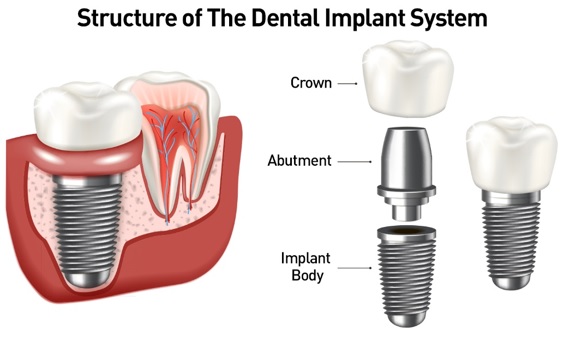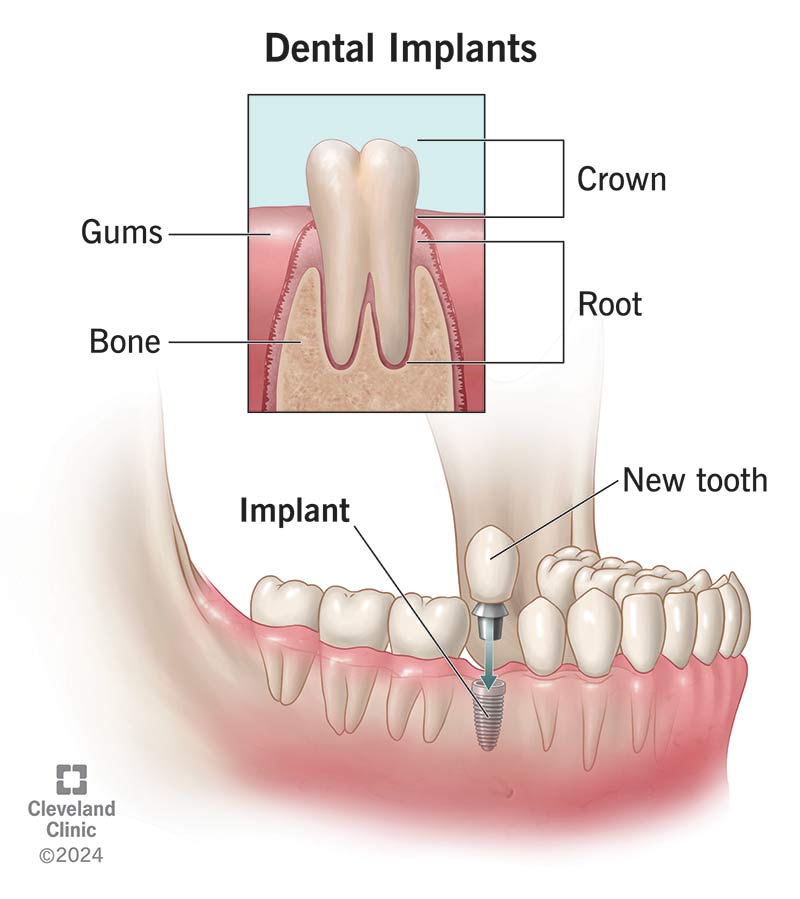Not known Factual Statements About Dental Implants
About Dental Implants
Table of ContentsHow Dental Implants can Save You Time, Stress, and Money.The Definitive Guide for Dental ImplantsThe Basic Principles Of Dental Implants How Dental Implants can Save You Time, Stress, and Money.
are clinical tools operatively implanted right into the jaw to bring back an individual's capacity to chew or their look. They offer assistance for synthetic (phony) teeth, such as crowns, bridges, or dentures. When a tooth is shed because of injury or condition, an individual can experience problems such as fast bone loss, malfunctioning speech, or changes to chewing patterns that lead to discomfort.
Structure of The Oral Implant System selecting dental implants, talk to your oral copyright regarding the potential advantages and dangers, and whether you are a prospect for the procedure. Points to think about: Your total health and wellness is a crucial factor in figuring out whether you are a good candidate for oral implants, how long it will certainly require to heal, and just how long the implant might stay in area.
Cigarette smoking might affect the healing procedure and decrease the long-lasting success of the dental implant. The healing procedure for the dental implant body may take a number of months or longer, throughout which time you normally have a short-term joint instead of the tooth. the oral implant treatment: Thoroughly adhere to the oral hygiene directions offered to you by your dental copyright.
5 Simple Techniques For Dental Implants
Implant failing can result in the demand for one more medical treatment to fix or replace the dental implant system. Brings back the capability to eat Brings back cosmetic appearance Assists keep the jawbone from shrinking due to bone loss Preserves the health of the surrounding bone and gum tissues Aids maintain surrounding (neighboring) teeth secure Boosts top quality of life Damages to bordering natural teeth during implant positioning Injury to the surrounding cells during surgical procedure, such as sinus opening Injury during surgery (as an example, crack of surrounding jawbone) Inadequate feature, such as seeming like the teeth do not bite together generally An experience that the tooth hangs or twisting in position arising from an abutment screw loosening Implant body failing (looseness of the implant body) due to systemic infection, which may be most likely in clients with uncontrolled diabetes mellitus because of local infection in bone and gums sustaining the implant body as a result of delayed healing, which might be much more see most likely in individuals who smoke Trouble cleaning up the gum tissues around the dental implant, resulting in inadequate oral health Unattended periodontal illness Post-surgical tingling as a result of nerve impingement or damage Always notify health and wellness care service providers and imaging service technicians that you have oral implants before any magnetic resonance imaging (MRI) or x-ray procedures.
FDA is not conscious of any negative occasions reported for MRI or x-ray procedures with oral implants. Oral implants systems are normally made from products that adhere to international agreement criteria of the International Company for Standardization (ISO) or ASTM International. These criteria have information of what makes a risk-free product.
Oral dental implant systems are examined according to global agreement standards. Biocompatibility screening, to show that bodily contact with the tool does not create complications like irritability or sensitive reaction, is part of the evaluation that assists guarantee the materials in the oral implant system are safe and do not trigger unfavorable effects when implanted in individuals.

7 Simple Techniques For Dental Implants
Some individuals are not eligible for dental why not look here implant surgical treatment. It is for oral cosmetic surgeons to operate people with: intense illnessuncontrollable metabolic diseasebone or soft cells disease or infectionIf these issues are resolved, an individual can have the surgical treatment. Dental Implants. In, oral specialists refrain from running on people with: If individuals with any one of the above go through oral implant surgical procedure, there is a greater danger of the dental implant falling short
Some individuals have a jawbone abnormality that stops enough bone for an implant from developing. In such situations, a surgeon might need to carry out a ridge adjustment. This involves lifting the gum tissue to subject the location of deformed bone. The cosmetic surgeon will after that make use of a bone or bone replacement to repair and construct up the area.
Oral dental implant surgical procedure is an individualized procedure. It's not the same for everybody. But the complying with gives a general summary of what you can anticipate your dental expert, oral specialist, periodontist or prosthodontist to do: Place the dental implant surgically. Give you time to recover. Connect the post and last crown, bridge or denture.
Next off, your specialist will very carefully place the oral implant right into your jaw. If your dental implant is near the front of your mouth, your dental expert will make a short-lived tooth for you to wear until you heal.
The Best Guide To Dental Implants
Throughout the recovery stage, your jawbone should fuse to the dental implant. This procedure can take anywhere from 3 to 9 months.
When your dental implant heals, your dentist can connect the joint (tiny connector message) and your final reconstruction (crown, bridge or denture). This generally takes about one hour to finish and might call for a second minor surgical procedure. You should not really feel any type of pain during your oral implant procedure because your service provider will utilize drug to numb your periodontals.